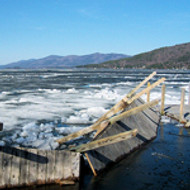5 Top Tips to Maintain Your Dock Deicer
11th Jan 2016 | Posted by The SavvyBoater Staff
If you left your boat in the water this winter, it’s time to make sure you’re maintaining your deicer. It’s an expensive thing to discover an ice damaged boat in the spring. Maintaining your deicer is the best way to avoid that.
Here are our 5 top tips to maintain your dock deicer or ice eater this winter.
1. Inspect your deicer regularly

And by regularly, we mean at least once a week, or more frequently if possible. Big problems often start as small ones. If you catch them when they’re small, they’re easier to fix.
If you can’t get to your boat at least once a week, every week this winter, get help. Is there a family member, neighbor or dock manager who’ll check on it for you?
You (or your handy helper) are looking for any damage, clogs, leaks, odors, unusual noise or changes in performance.
- Unplug the deicer or ice eater
- Remove it from the water
- Check for and remove any debris in the system
- Check for and remove any debris wrapped around the motor shaft (plastic bags and fishing line are common culprits)
- Inspect the propeller for damage
- Check the zinc anode for deterioration. If it’s turned white or reduced to half its original size, it needs replacing. NOTE — you should check the zinc anode every two to three months, even if your deicer is working normally. Using the deicer when the zinc anode is deteriorated can cause metal deterioration and contamination, and might void your warranty.
- Check the mount, stand or ropes for wear and tear
2. Use a GFI or RCD
Always use a Ground Fault Interrupter (GFI) or Residual Current Device (RCD). They’re devices that sense current flow problems and automatically shut off if there’s a problem. Simply put, they could save your life.
Check your GFI or RCD is working properly:
- When you first get it
- Every time you re-install it, plus
- Monthly.
3. Check your depth
Water levels can fluctuate throughout the winter. If your deicer comes too close to the floor, you risk clogging the motor with debris and damaging the propeller. Make sure it stays at least one foot off the bottom.

It should also be three to five feet below the water’s surface when operating.
NOTE — If you’re working with shallow water, check it doesn’t freeze solid. This is particularly important if it’s a colder winter than usual. Your deicer won’t be able to work properly if the water around it is freezing all the way through.
4. Check the water
Objects in the water — even the ones that are supposed to be there (boat hulls, dock floats, pilings etc.) — can affect the performance of your deicer. Your deicer creates a warm water flow and an object in the way might change or restrict the water flow, which may make it less effective.
Look at the objects in the water, and check if they’re interfering with the warm water flow. If you can move those items, great. If not, you might need to adjust your deicer’s position to work around them.
Check, too, for unexpected objects (like debris) that may appear throughout the winter. Remove these wherever possible.
5. Check with the manufacturer
Every deicer brand and model is slightly different. The recommended maintenance for Power House Ice Eaters may be different than that for Kasco Deicers, so be sure to follow each manufacturer’s guidelines. Check the packaging or online for those guidelines.
Following them will prolong the life of your deicer, and your boat. And your warranty might become invalid if you don’t.
Buying a new deicer is not cheap, so heading down to the dock to maintain your deicer is well worth it. It’ll ensure your deicer stays in top condition and keep your boat well protected.


